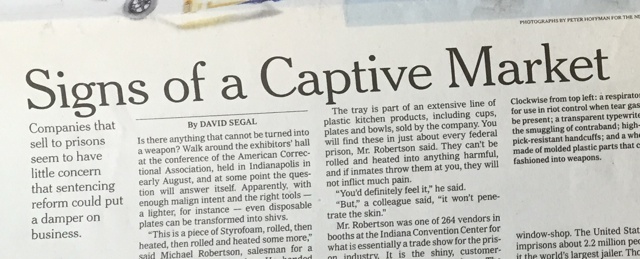Prison industry vendors react to “prison reform” talk
David Segal in the New York Times investigates whether companies that sell things to prisons feel threatened by the talk of prison reform.
by Peter Wagner, August 31, 2015
 A huge spread in the Business section of the Sunday New York Times focuses on reporter and columnist David Segal’s recent trip to the American Correctional Association conference, where he met companies of all sorts who sell prisons and jails the raw materials — except for people — needed for a prison or a jail. Segal, who also writes as The Haggler covering consumer protection issues and who previously blew the lid off the mugshot blackmail industry here grapples with the questions of policy change and what the companies who profit from the $80 billion spent on corrections each year are doing in response to all of the talk of prison reform:
A huge spread in the Business section of the Sunday New York Times focuses on reporter and columnist David Segal’s recent trip to the American Correctional Association conference, where he met companies of all sorts who sell prisons and jails the raw materials — except for people — needed for a prison or a jail. Segal, who also writes as The Haggler covering consumer protection issues and who previously blew the lid off the mugshot blackmail industry here grapples with the questions of policy change and what the companies who profit from the $80 billion spent on corrections each year are doing in response to all of the talk of prison reform:
For prison vendors, this would appear to be a historically awful moment. Sentencing reform has been gaining momentum as a growing number of diverse voices conclude that the tough-on-crime ethos that was born 40 years ago, and that led to a 700 percent increase in the prison population since 1970, went too far. Mandatory minimum laws, many of them passed at the state and federal level in the ’70s, ’80s and ’90s locked people away for decades, often for relatively minor, nonviolent offenses. Those laws have had a disproportionate impact on African-Americans, who tend to serve longer sentences than whites.
But I’m quoted in a section that goes further to draw a line between all the reform that’s being talked about and what reform has actually looked like:
[The] vendors in Indianapolis seem unruffled by talk of prison reform. It hasn’t had a big impact, at least not yet, and it doesn’t seem that it will in the future.
To understand the “not yet” part, consider California, site of the country’s most ambitious inmate reductions. The court-ordered program to ease cramped, triple-bunk conditions started in October 2011. To date, the system’s head count in the 34 facilities covered by the overcrowding litigation has dropped to 111,000, from 144,000.
But the numbers aren’t quite what they seem. The law passed in 2011 mandated that new offenders sentenced for nonviolent or nonsex crimes would serve their time in county jails. The days when a jail was a just a pretrial holding pen are over, and the population in those cells is starting to bulge. Yes, there has been a net decline in the total population of incarcerated people in the state. Just not at a rate that would alarm anyone selling, say, inmate blankets.
“These declines are too small,” said Peter Wagner of the Prison Policy Initiative, which campaigns for prison reform. “The numbers are trending downward, but slowly and not consistently.”
Mr. Wagner also doubted that prison reform laws knocking around Congress, as well as many states, would reduce the prison population as much as some people thought, because they are focused on drug and nonviolent offenders. As numbers collected by the Urban Institute demonstrate, half of all inmates in state prisons are violent offenders, and state prisons are home to 86 percent of the nation’s inmates.
 Segal addresses another reason why some of these companies aren’t bothered by talk of prison reform: there are plenty of ways to profit if governments merely transfer their prison addictions to other unnecessary forms of social control. Segal reports:
Segal addresses another reason why some of these companies aren’t bothered by talk of prison reform: there are plenty of ways to profit if governments merely transfer their prison addictions to other unnecessary forms of social control. Segal reports:
[M]any companies are trying to diversify. In 2013, Corrections Corporation of America, the country’s largest private prison company, purchased Correctional Alternatives, which specializes in re-entry programs, like work furloughs and home confinement.
“We have continued to look for opportunities in this service area,” a spokesman for C.C.A. wrote in an email. “It aligns with the needs of our government partners, who are increasingly looking to this type of solution.”
Many at this conference were what could be called platform agnostic, including Norix, which describes itself as the country’s largest maker of prison furniture. Its slogan is “Engineered to endure,” and to illustrate the point, the company ran a looping video at its booth featuring inventive assaults on its furniture. One snippet featured a vinyl armchair being slowly squashed down to 10 inches high by a pneumatic crusher.
When the machine slowly uncrushed the chair, it retook its original shape.
“Sales to prisons are flat to down,” said Sandy Heitman, a senior project manager. “But more people are being put into mental health facilities, and that portion of the business has increased.” The same is true, she added, of halfway houses.
We sat on some Norix furniture, which was the opposite of the austere, steel slabs you see in prison documentaries. Norix still makes that style of product, but it was highlighting a vinyl collection that comes in lively colors that the company calls lime, mango, orchid and reef. The furniture is intended to be more “humanizing,” a word that is prominent on the company’s website.
“This is a more healing environment,” Ms. Heitman said, gesturing to the products.
As she spoke, the video showed a man in a lab coat jackhammering a chair.
Segal’s article provides a powerful jumping off point for two important questions that long-time prison reformers should be grappling with:
- How much of our support from unexpected allies comes from a real desire to treat other people humanely and how much comes from a desire to tweak the system in order to simply create new avenues for profiting off of other people’s pain?
- How many of the “reforms” currently being considered in this country are no more innovative than taking a sleeping slab and coloring it mango?




This is crazy. I know every time I visit my son imprison I have to pay a fortune for something to eat. Example frozen pizza French bread style cost $8.50 from a vending machine. This is highway robbery. My visit typically cost about $70.00 to feed my incarcerated son and two grandchildren. Ouch! My son has an excessive sentence of 70 years to life for stealing property check out his story. http://www.Jeremysstory.com
[…] in the Senate that would abolish private prisons. Peter Wagner writes about how private prisons haven’t been too concerned with prison reforms up to this […]
[…] rush of private money to fuel the development of “alternatives” to incarceration like electronic monitoring or private probation services that ensnare people who previously would never have been under […]
Great piece but none of this should be found surprising. For the past 20 years there’s been many cries about “cell-stuffing” to monetize via mass incarcerations. This was even rather evident and found to be factual in the Ferguson case.
The 3-time looser law was pushed by the pro-prison lobbyists and implemented in order to continue to generate revenue for the industry.
Prison reform is a start but the ultimate goal is to prevent the need to incarcerate. This can only be done by eliminating poverty. Most crimes committed in the many ghettos are considered survival-based crimes. Such families are forced to live on limited to no income to street tactics to survive becomes the norm. Rid the country of poverty means ridding itself of these types of crimes.
We must also agree to abolish the systemic tactics that causes recidivism.
We must reinstate educational programs in prisons
We must eliminate superfluous background checks meaning, the results of such a check should only return results related to the job applied for. for example, if I was convicted of robbery and applied for a job working in a bank, the background check for reveal this fact.
However, if I were convicted of selling drugs and applied for the same job, the background check should not return any results.
In most cases, former inmates who become gainfully employed tend NOT to commit crimes on the job. This is a fact! Most crimes committed on the job are by those who have clean records. This is a fact and I can testify to this myself.
In 1984 I was convicted with the star of the HBO series “The Wire”. I served three years in prison. While there I completed my GED. 20 years later, I became a partner in mid-sized marketing firm where I led digital efforts. This, without a college degree. I am a working example of what can happen when one is offered a hint of opportunity which is all that society need.
We can resolve and dissolve this national crisis but we must first become human… no truly human and want for every human what we would want for ourselves.
Let’s start there!
[…] of the system in mind will make it that much easier for advocates to steer clear of reforms that simply transfer people from one piece of the correctional control pie to another and think more expansively about what […]